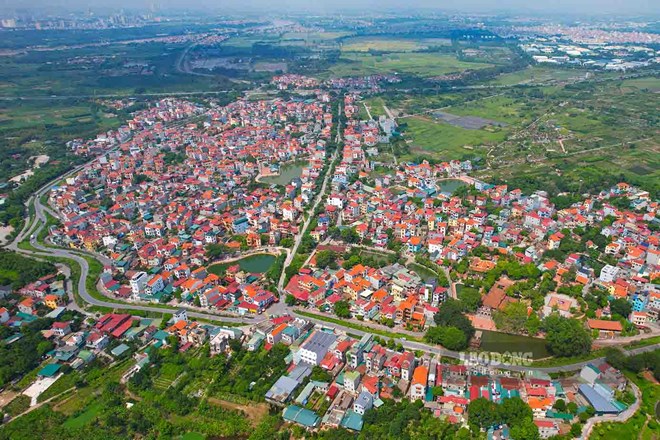On the afternoon of November 26, with the majority of delegates in favor, the Hanoi People's Council passed a resolution regulating the first land price list to be announced and applied from January 1, 2026.
Accordingly, the new land price list in Hanoi has the highest price of up to more than 702 million VND/m2, applied to location 1 (road surface) on streets in the central area of the old Hoan Kiem district. This level increased by about 2% compared to the old land price list.
Residential land prices have increased sharply in suburban communes. Of which, area 9 (including communes of Lien Minh, O Dien, Dan Phuong, Hoai Duc, Duong Hoa, Dong Son, An Khanh) had the highest increase, about 26%. The highest land price in this group is 64.7 million VND/m2, applied to location 1 on National Highway 32 (from the border with Xuan Phuong Ward to the intersection into Kim Chung - Di Trach urban area).
Area 7 (including 9 communes of Tien Thang, Yen Lang, Quang Minh, Me Linh, Phuc Thinh, Thu Lam, Dong Anh, Vinh Thanh, Thien Loc) and area 10 (including 12 communes of Dai Thanh, Thanh Tri, Ngoc Hoi, Nam Phu, Binh Minh, Tam Hung, Thuong Tin, Hong Van, Thanh Oai, Dan Hoa, Thuong Phuc, Chuong Duong) with an increase of 25%.

The Vietnam Real Estate Association (VNREA) believes that the land price list is increasing, and the cost of real estate investment in suburban areas is also increasing. This reduces the attractiveness of investment projects and affects the housing development plan in suburban areas to expand people.
From there, the housing supply in the market may continue to decrease. At the same time, commercial housing prices have also increased, reducing the ability to access housing for people with real needs.
According to the Vietnam Real Estate Association, the real estate market is in the recovery phase, many businesses have to restructure. Therefore, increasing land prices at this time can become a double burden, slowing down the recovery process.
" Increasing land prices will lead to greater financial obligations for businesses and people. At the same time, the budget burden also increased when implementing compensation, support, and resettlement," VNREA stated.
The land price list is used as a basis for calculating compensation, determining land prices for resettled people and people compensated for residential land; calculating land use tax, personal income tax from land use rights transfer. This is also the basis for collecting fees and charges related to land use, transfer or when carrying out administrative procedures on land such as issuing red books.
Commenting on this, in an interview with Lao Dong, Lawyer Nguyen Van Dinh - real estate legal expert - said that the increase in the land price list will indirectly push up specific land prices, because specific land prices are calculated according to comparison methods, income and surplus must not be lower than the price according to the land price list, leading to the land price list becoming "floor price".
Thus, in case the State allocates land to implement a project, the enterprise will have to pay more, helping to increase revenue for the budget. Or in the case of land recovery by the State, people are also compensated close to market prices, helping to reduce disputes and complaints in the land sector...
However, Lawyer Nguyen Van Dinh said that, in another aspect, the land price list can disrupt people's lives, causing costs related to land use to increase.
For example, cases of paying land use fees when the State recognizes land use rights (issuing a first book), allowing the change of land use purpose of households and individuals; paying annual land rent; calculating land use tax; registration fees and especially income tax from transferring land use rights... are all based on the land price list.
According to the lawyer, if the land price list increases twice, the land use fee, tax, fee, fee... that people have to pay will be double the amount, while this is a group of entities with a large number. The land price list will certainly cause a wide-range, inclusive impact.
For simple example, non-agricultural land use tax is still considered a "smooth" collection because the tax rate is only 0.03% of the land price in the land price list. But now if the land price list is adjusted up 5 times, this fee will become a burden for many people.
Regarding the solution, according to Lawyer Nguyen Van Dinh, management agencies need to consider adjusting the system of legal documents related to tax obligations, fees, charges, land use fees, and land rents.
For example, for income tax from land use rights transfer of households and individuals, the current Law on Personal Income Tax stipulates a tax rate of 2% and is calculated according to the land price list. With the assumption of an increase in the land price list, the 2% tax rate needs to be studied to adjust down so as not to increase the tax burden for entities," said Lawyer Dinh.
According to the lawyer, in fact, this solution has begun to be applied by the State. For example, according to Decree No. 103/2024 on land rent collection, in case of land lease with annual payment, the annual land rental price is calculated as a percentage multiplied by the land price for calculating land rent.
Decree 103 stipulates a percentage ranging from 0.25% to 3% (this rate was previously from 1% to 3%). Thus, Decree 103 has reserved that in case of 4 times increase in land prices, people's land rent will remain stable.











